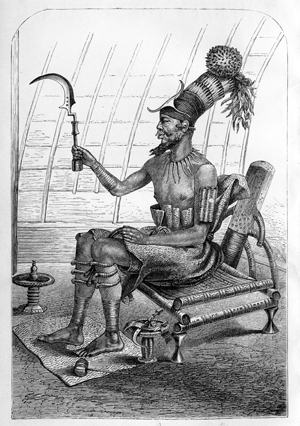
“Dinka Cattle-Park”
The accompanying illustration is designed to exhibit something of the daily routine of the Dinka. It represents one of those murahs or cattle-parks, of which I have seen hundreds. It depicts the scene at about five o’clock in the afternoon. In the foreground there are specimens of the cattle of the country. The men in charge are busied collecting up into heaps the dung that has been exposed during the day to be dried in the sun. Clouds of reeking vapour fill the murah throughout the night and drive away the pestiferous insects. The herds have just been driven to their quarters, and each animal is fastened by a leather collar to its own wooden peg. Towards the left, on a pile of ashes, sit the owners of this section of the murah. The ashes which are produced in the course of the year raise the level of the entire estate. Semi-circular huts erected on the hillocks afford the owners temporary accommodation when they quit their homes some miles away and come to feast their eyes upon the goodly spectacle of their wealth. [Vol. 1, pp. 166-167, of the English edition]

“A Niam-Niam Minstrel”
As the darkness came on, our camp was enlivened by the appearance of the grotesque figure of a singer, who came with a bunch of feathers in his hat, and these, as he wagged his head to the tune of the music, became entangled with the braids of his hair. Altogether the head was like the head of Medusa. These “minne-singers” among the Niam-niam are known as “nzangah.” They are as sparing of their voices as a worn-out prima donna; except for those close by, it is impossible to hear what they are singing. Their instrument is the local guitar, the thin jingling of which accords perfectly well with the nasal humming of the minstrel’s recitative. . . . The minstrels of the Niam-niam may be said to have the character of a lover’s whisper. [Vol. 1, pp. 445-46]

“King Munza in Full Dress”
I could now feast my eyes upon the fantastic figure of the ruler. I was intensely interested in gazing at the strange weird-looking sovereign, of whom it was commonly reported that his daily food was human flesh. With arms and legs, neck and breast, all bedizened with copper rings, chains, and other strange devices, and with a great copper crescent at the top of his head, the potentate gleamed with a shimmer that was to our ideas unworthy of royalty, but savoured far too much of the magazines of civic opulence, reminding one almost unavoidably of a well-kept kitchen! His appearance, however, was decidedly marked with his nationality, for every adornment that he had about him belonged exclusively to Central Africa, as none but the fabrications of his native land are deemed worthy of adorning the person of a king of the Monbuttoo. Agreeable to the national fashion a plumed hat rested on top of his chignon, and soared a foot and a half above his head; this hat was a narrow cylinder of closely-plaited reeds; it was ornamented with three layers of red parrots’ feathers, and crowned with a plume of the same. . . . The muscles of Munza’s ears were pierced, and copper bars as thick as the finger were inserted in the cavities. The entire body was smeared with the native unguent of powdered cam-wood. . . Halfway up the lower part of his arms and just below the knee were three bright, horny-looking circlets cut out of hippopotamus-hide, likewise tipped with copper. As a symbol of his dignity Munza wielded in his right hand the sickle-shaped Monbuttoo scimitar, in this case only an ornamental weapon, and made of pure copper. [Vol. 2, pp. 44-45]

“King Munza Dancing Before His Wives”
Munza’s visits made a diversion in our camp life. . . . Towards midday the news was brought that the excitement [celebration of victory over a local tribe] was reaching its climax, and that the king himself was dancing in the presence of his numerous wives and courtiers. . . . The scene that awaited me was unique. Within the hall there was a spacious square left free, around which the eighty royal wives were seated in a single row upon their little stools, having painted themselves in honour of the occasion with the most elaborate care. . . . Munza was as conspicuous in his vesture as he was astounding in his movements. . . . [H]e had now attired his head in the skin of a great black baboon; the peak of this was dressed up with a plume of waving feathers. Hanging from his arms were the tails of genets, and his wrists were encircled by great bundles of tails of the guinea-hog. A thick apron, composed of the tails of a variety of animals was fastened round his loins, and a number of rings rattled upon his naked legs. But the wonder of the king’s dress was as nothing compared to his action. His dancing was furious. [Vol. 2, pp. 74-75]